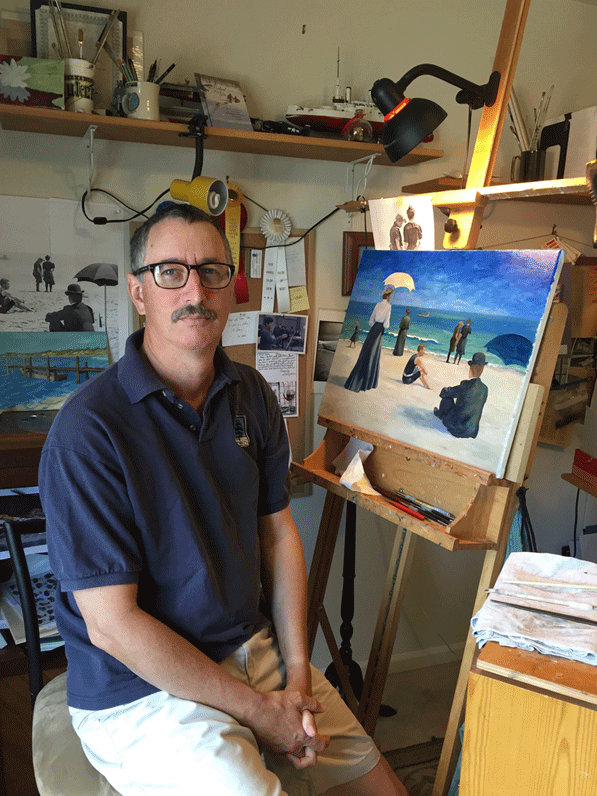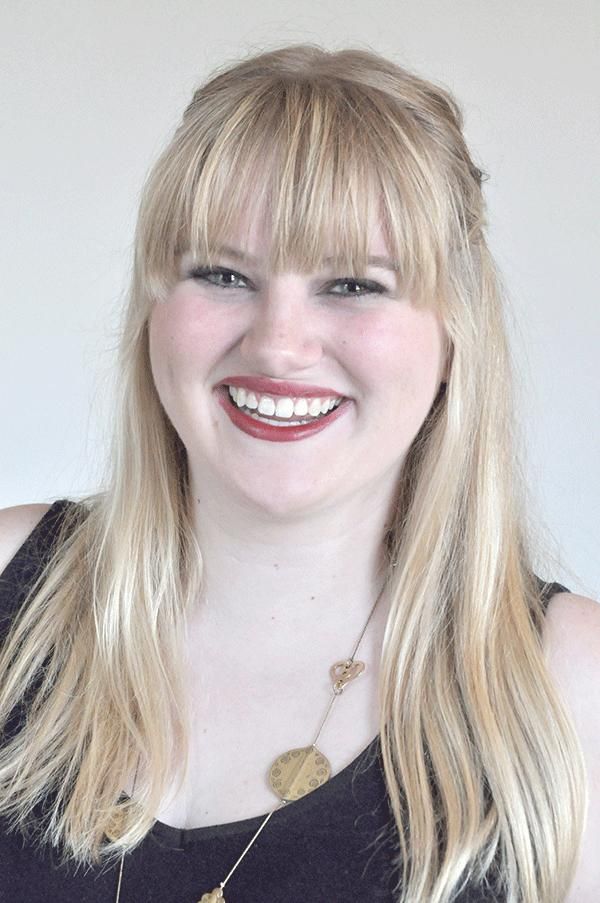With reading glasses perched at the tip of his nose and a brush spiked with just a few, well-manicured hairs in his hand, Sam Hoffman begins another hour of painting. His tiny paintbrush lays down thin lines and meticulous detail that many of us of a certain age, can’t fully appreciate without the aid of magnification. Detail and accuracy are Hoffman’s trademark; he is able to put oil paint on a canvas with the control of a surgeon. Think tiny, tiny men, Naval officers smaller than one’s fingernail lining the perimeter of a massive warship. These guys aren’t painted as fuzzy hints of figures but rather each is fully decked out in uniform, and facial features suggest their unique personalities.
One can guess that Hoffman’s commitment to accuracy can, in part, be attributed to his time spent in the Navy where he took documentary photographs. The ships that serve as the subjects of many of his paintings come from the photographs Hoffman collected over his 10 years of service.
After his time in the Navy, Hoffman earned a photojournalism degree from Indiana University, Bloomington. You may be familiar with his work; he’s been shooting pictures for the Journal Gazette for the past 27 years. Look online or in print, you can’t get away from Hoffman’s pictures. He shoots everything – from art to house fires – but these days he is partial to assignments that lead him to Parkview Field to catch a TinCaps game.
Hoffman is of the generation of photographers who worked through the transition from film to digital. For him, when the switch was made, much of the creative process was taken away.
“After the Journal closed their darkroom I kept a wet darkroom at home, but even that wasn’t satisfying enough. I could make a really nice print in 15 minutes, but then the process was over. I could even make 20 copies of that print, but it just wasn’t enough,” says Hoffman.
According to the artist, he craved a medium that demanded more time and more input on his behalf. He went to his wife, Jan Hoffman, who is also a practicing artist and art educator for help. She first led him to watercolor, which was a quick turnoff.
“I wasn’t good enough for watercolor because once you make a mistake, you can’t go back. You can’t paint it out,” he says, explaining why he switched to oils 15 years ago.
His early paintings were those of the aforementioned ships, but he struggled with those as well.
“It’s hard to paint water in an acceptable way when you live 13 hours away from the ocean.”
Feeling deprived of resource material, Hoffman moved forward with what he describes as urban realism, paintings of people living and moving through a city setting.
He enjoys the challenge of the human figure. The proportions that are vital to keeping a human looking like a human are intriguing and absolute. Early sketches and compositions of Hoffman’s paintings are plotted and marked with dozens of carefully laid measurements.
“I had to sketch this one out four times,” he says when describing a current example of his work. “Sometimes the math just doesn’t work out. That’s why I don’t do watercolor.”
Not surprisingly, Hoffman turns to photographs rather than live models as reference for his paintings. During a summer visit to Paris, he, his wife and daughter collectively brought home over 2,500 images of the city. Feeling the exuberance of new inspiration, he already has three new paintings in the works, all of which are composed from the Paris collection.
When Hoffman begins a new canvas, he first puts down lines with charcoal. Not with pencil, mind you, as he explains the graphite can separate and float up through the paint, making the preliminary drawing visible in the finished painting.
When satisfied with the preliminary drawing, which provides him with landmarks and essential points from which he will grow the painting, Hoffman makes the outlines. He chooses his colors with intention and makes the first outlines with raw umber which (Hoffman interjects a fun fact) dries faster than most colors and allows the artist to move forward with less wait time. Payne’s Grey follows, blocking out the shapes. He next moves on to adding color to create areas of shadow and light. He works forward in the painting, adding layer by layer until he reaches the point of fine detail.
While Hoffman’s life’s work has ingrained the need for accuracy and realistic representation of his subjects, something inside the artist is pulling him to make a change.
“I’m trying to loosen up. I think it just looks better,” he says. “I’m influenced by Edward Hopper – not so much detail but more color and light. I wish I could do that.”
Hoffman is pushing himself out of his comfort zone. He’s trying new techniques, handling his brush in different ways.
“It’s hard to get away from the detail. So many years of photography … it has to be realistic … you can’t change things. As a journalist you can change a bit of the contrast, but you can’t change anything fundamental in the photograph. It took me many years of painting to realize that I don’t have to do that. I can take three photographs and meld them together to make a new painting. I can change that. It’s okay. I should change that!”
The massive collection of photos brought home from Paris has inspired Hoffman to continue to push himself into new territory. A particular photo, one of women gathering at a café huddled together to look at a single cell phone, seemed an interesting challenge for the artist.
“I’m really going to have to loosen up,” he says. “It’s really going to be a challenge for me because there’s so much detail in the shadows – all the angles of the elbows.” Hoffman’s mind drifts and focuses on the piece currently on his easel as he seems to visualize the next steps he plans to take.
Hoffman’s dedication doesn’t go unnoticed. He recently received the Juror’s Recognition Prize at the prestigious Hoosier Salon. He has shown work in galleries in Oregon, North Carolina and at the National Museum of Naval Aviation in Pensacola, Florida. He currently has nine pieces hanging at Castle Gallery which will be on view until mid September.


